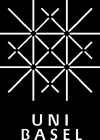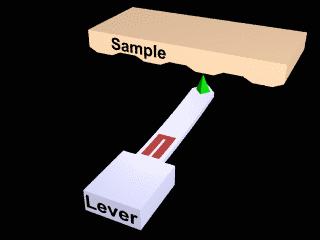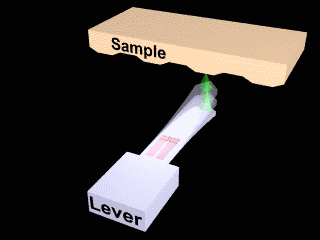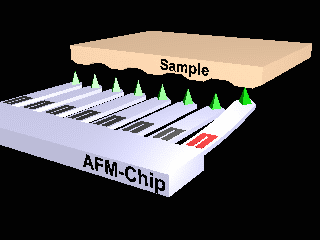
Home
Why on Mars?
Principle
Hardware
Animations
Links
People
Partners
Principle of AFM-Imaging
An Atomic Force Microscope (AFM) consists of a extremely sharp tip mounted or integrated on the end of a tiny cantilever spring which is moved by a mechanical scanner over the surface to be observed. Every variation of the surface height varies the force acting on the tip and therefore varies the bending of the cantilever. This bending is measured by an integrated stress sensor at the base of the cantilever spring and recorded line by line in the electronic memory. The interaction between tip and surface can be compared with the good old turntable pickup, but the force in the AFM is about 1 million times smaller. The Mars-AFM is designed for a resolution of 10 nanometers in a image range of 10 micrometers.
 |
Static mode:In the static mode of the Mars-AFM, as explained above, the tip is in contact with the surface. At the front of the cantilever spring a (green) tip is mounted and the (red) force sensor is integrated on the base.
|
 |
Dynamic mode:In this mode the tip is not in contact with the surface. The cantilever spring is oscillated at its resonance frequency, which is influenced by changing forces from the sample. The frequency deviation is used to make an image of the sample. The dynamic mode has the big advantage of not wiping away loose Martian soil particles.
|
 |
AFM-Chip with 8 cantilevers:For redundancy the Mars-AFM is equipped with 8 addressable sensors and cantilevers on one chip. Only one at a time is used for imaging. If a tip is worn or dirty it can be broken off by a command from Earth.
|
AFM-System on Mars:For each experiment a job list is sent from Earth, via the Orbiter to the Lander computer on Mars. The following operations then run fully autonomously. First the Martian soil containing water ice is scooped by the robot arm and loaded on to a sample plate. Then the sample wheel is rotated by 180 degrees and approached to within the scan range of the AFM. Afterwards the electronics moves the scan head and with the selected cantilever, it makes an image of the sample. Finally the images are stored on the Lander computer and after a hard Martian day’s work, sent down to Earth.
|
||
|
